Unsure about your French table manners? Click Here to download > > How to avoid these 10 food etiquette mistakes !
- Home ›
- Destinations ›
- Loire Valley ›
- Cheverny Castle
9 Things To Know Before Visiting Chateau De Cheverny
Published 9 December 2024 by Leyla Alyanak — Parisian by birth, Lyonnaise by adoption, historian by passion
Cheverny is a much-loved castle in the Loire Valley, known as the inspiration for Moulinsart (Marlinspike Hall in English), home of Tintin’s friend, Captain Haddock. But Tintin is only a tiny part of Cheverny’s story. I recently spent a day at the château and learned of its marvelous history of scandal and survival.
With its 400,000 annual visitors, most of them French, Cheverny is not the most visited castle in the Loire Valley, not when you compare it with, say, the behemoth of Chambord or the beloved Chenonceau, both visited by well over a million people a year.
But Cheverny is different. It's eclectic, its architectural style is different − neither fortress nor ornate Renaissance but a Classic building whose clean, elegant lines fall somewhere in-between.
Consider this: it survived destruction twice, has been in the same family for six centuries (they still live in it!), has more than 100 hunting dogs on the property, bears a distinct resemblance to Marlinspike Hall in the Tintin comic book series, and its walls are covered with a combination of priceless tapestries that hang next to... LEGO reproductions.
If that doesn’t make you want to explore this unusual jewel, nothing will.
NOTE: Pages on this site may contain affiliate links, which support this site. See full Privacy Policy here.
1. Cheverny was almost destroyed − twice
Cheverny was built between 1624 and 1630 by the Hurault family, on top of an earlier fortress which was razed to make room for the new structure.
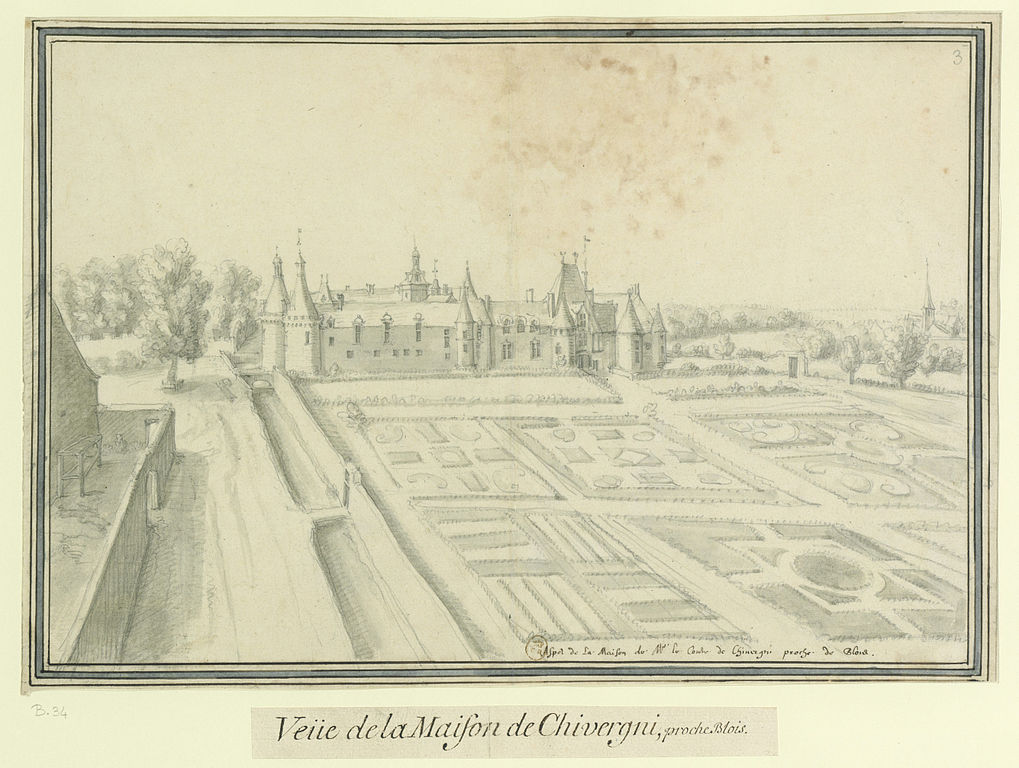 Drawing by Étienne Martellange of Cheverny as it was in the early 17th century
Drawing by Étienne Martellange of Cheverny as it was in the early 17th centuryCheverny almost didn’t make it.
During the French Revolution, many castles belonging to the nobility were destroyed, and Cheverny came close. It was owned at the time by an official who held the court position of “introducer of the ambassadors” under Louis XV, undoubtedly a position requiring great diplomatic skills.
He put these to use when the revolutionaries dropped by with the intention of burning the castle down.
Our diplomat, Jean-Nicolas Dufort de Cheverny, pointed with aplomb to the Roman statues adorning the façade. “We like new ideas,” he told them, presenting the statues as examples of enlightenment and openness who would have been open to progressive ideas.
And so the revolutionaries, convinced they had encountered a kindred soul, left (although at some point during the Revolution, the castle's archives were burned down).
The château’s resilience was further tested during World War II.
In a bid to protect France’s artistic heritage from Nazi looting, the Mona Lisa and other masterpieces were clandestinely stored in Cheverny’s orangery − as were different art treasures throughout the Loire castles.
One day, towards the end of the war, the Nazis came calling.
A conservator of national monuments had been staying at Cheverny during the war. Towards the end, tensions were rising as the Germans began their fallback towards Normandy. One SS group was fired upon by members of the Résistance, and responded with hand grenades, deciding to burn down the château along with the entire village.
“It turns out the museum conservator, Hans Hoeg, was Alsatian and spoke perfect German,” said Renaud Boyer, the castle’s manager and chief executive. “He began chatting with the SS, and next thing you know, they went on their way, only to be attacked again and routed just down the road.”
For the second time, Cheverny was spared, proving yet again that history often hangs by a thread.
2. It is a family affair
The Château de Cheverny has been within the same family, the Huraults de Vibraye, for 650 years, give or take.
Marquis Charles-Antoine de Vibraye and his wife Constance, unpretentious and clearly in love with their family home, live here with their three children, which is why you'll find touches of coziness throughout.
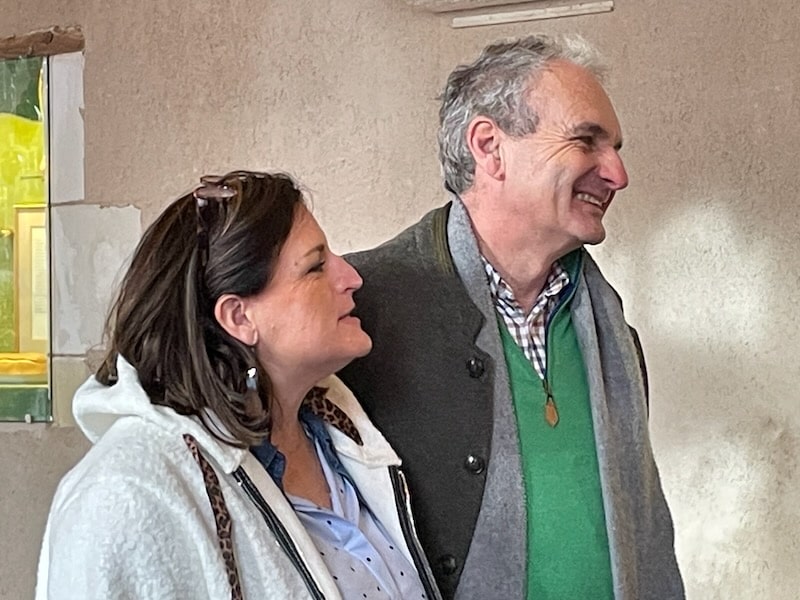 The Marquis and Marquise de Vibraye share their property's history and traditions ©OffbeatFrance
The Marquis and Marquise de Vibraye share their property's history and traditions ©OffbeatFranceThere were a few interruptions to the family’s ownership, the most renowned of which was perhaps the “Diane de Poitiers interlude”.
Diane was the mistress of Henri II, who had given her Chenonceau Castle as a gift. But when Henri died, his wife Catherine de Medici threw Diane out of Chenonceau and “convinced” her to accept Chaumont-sur-Loire instead. Diane then purchased Cheverny, from where she would supervise the work at Chaumont.
However, the Hurault family, who owned Cheverny, were powerful at court and were able to reverse the sale on a technicality. And so Cheverny reverted to its original owners.
Later, as the French Revolution rolled around, the family sold the chateau but would buy it back two decades later. It has stayed in the family ever since.
3. Scandal at the castle
Before Cheverny as we know it was built, there was another castle in its place and like any castle worthy of its name, it had its share of scandal.
It would seem that the castle’s owner under King Henri IV, Henri Hurault, spent much time away from home soldiering or courting, as a nobleman would.
That his wife played around was apparently a secret only to himself.
One day the king, walking through a gallery in the Louvre, jokingly made a two-fingered cuckold’s gesture behind Hurault’s head − which the aggrieved courtier caught in a mirror.
He rushed back to Cheverny and discovered his noble wife in bed with a page. The terrified servant jumped out the window, breaking a leg, but Hurault had no mercy and finished him off with his sword.
He then forced his wife to choose between the sword or poison; she chose poison and died within the hour. The King would exile Hurault to Cheverny for three years but would eventually relent and call him back.
Despite his absences, this time his wife − he was now married to a certain Marguerite − occupied her time blurring the past by overseeing the razing of the old fortress and the construction of the new Château de Cheverny, which stands today.
4. This is not your average Renaissance château
Unlike its nearby neighbors, like the grandiose Chambord or multi-faceted Blois, the château de Cheverny’s lines are classical Louis XIII, symmetrical, harmonious, and refreshingly understated.
The stone is tuffeau, a local limestone which has the unusual property of getting whiter and stronger with age.
But once you step inside, you’ll find anything but restraint − it’s a dazzling showcase of opulence, artistry, and meticulous care passed down the generations.
Cheverny is known for its ornate interior (a real contrast with its sober outside lines). Don't miss these three rooms:
The King’s bedroom
This is the heart of royal luxury, with its richly embroidered canopy bed (note the stunning Persian Isfahan design) and walls covered in intricate tapestries.
Every château was expected to have a king’s bedroom, in case the monarch stopped by on his travels. In Cheverny’s case, despite the welcoming hospitality, no king ever did.
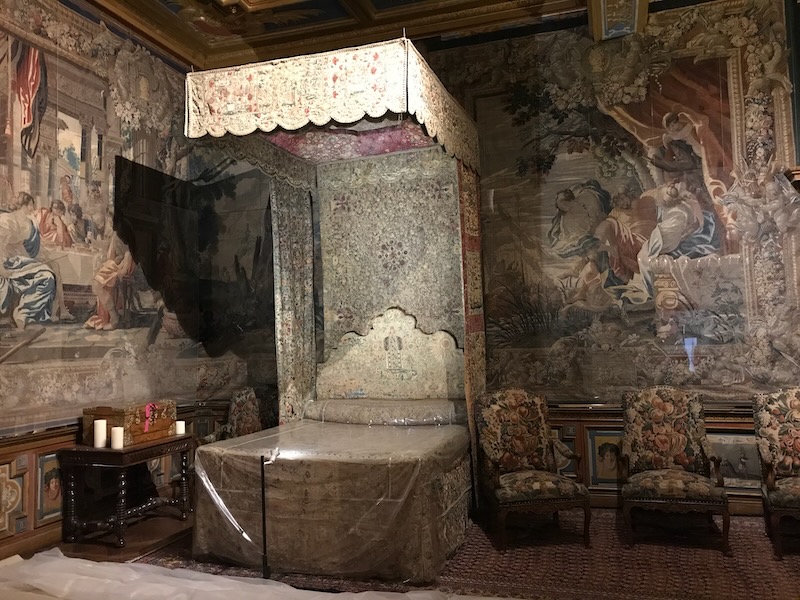 The royal bed in the Kings’ Bedroom ©OffbeatFrance
The royal bed in the Kings’ Bedroom ©OffbeatFranceThe dining room
The grandeur of this 17th-century room speaks for itself, with its massive oak dining table and period chairs. The walls are decorated with hunting scenes, which you’d expect on a hunting estate.
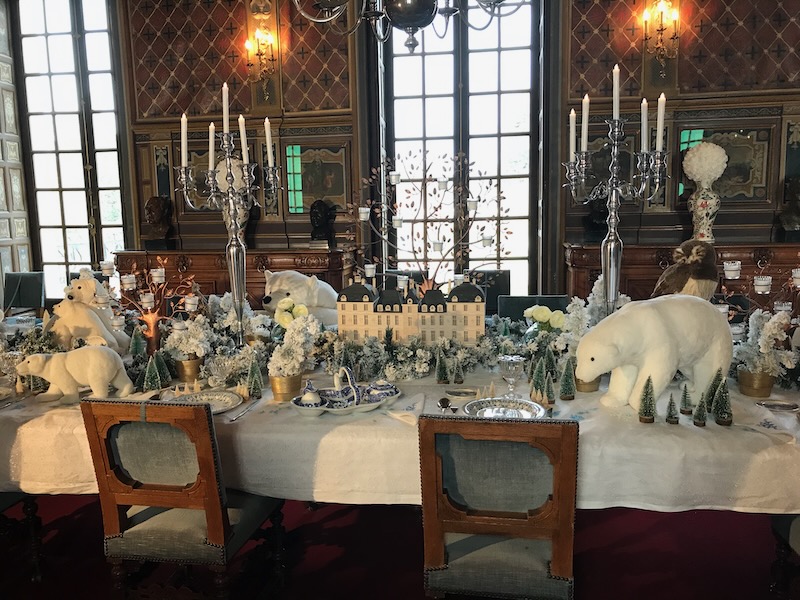 The dining room a past Christmas
The dining room a past ChristmasThe grand salon
It stands to reason that the château’s glorious Gobelin tapestries should be in this room, along with the fine ceiling woodwork and every possible painting, gilded mirrors and period furniture.
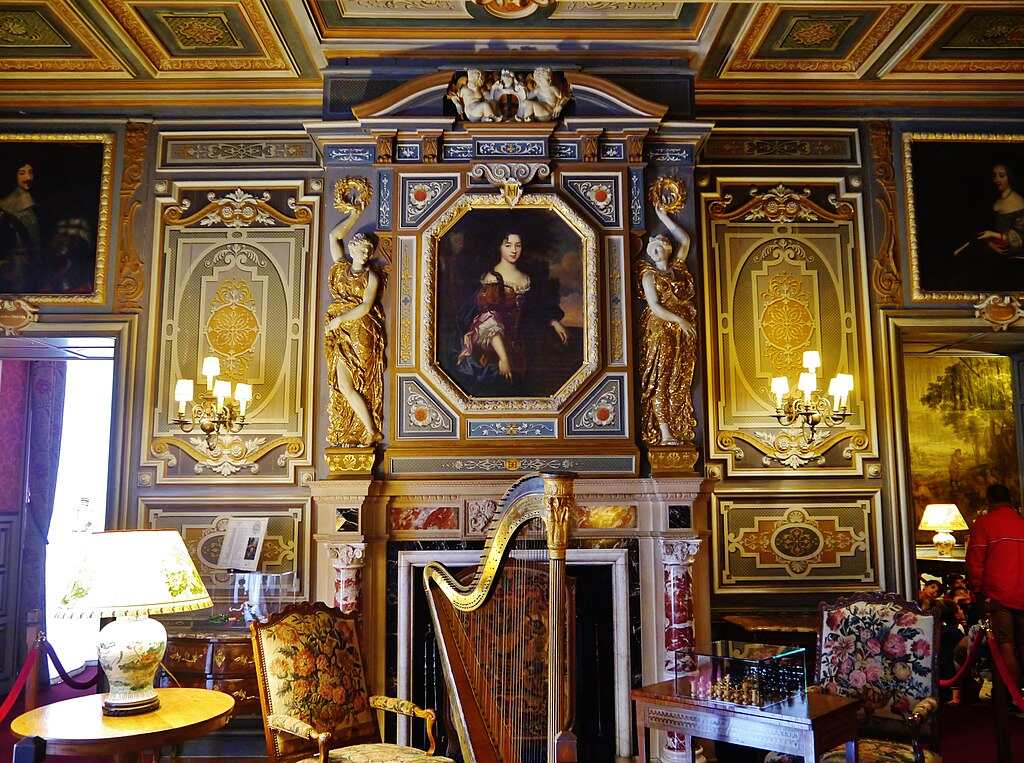 Grand Salon of Cheverny by Zairon, CC BY-SA 4.0, via Wikimedia Commons
Grand Salon of Cheverny by Zairon, CC BY-SA 4.0, via Wikimedia CommonsWHAT IF YOU DON'T HAVE A CAR?
A number of Loire Valley chateaux - including this one - CAN be reached without a car by using public transportation, mostly trains. So don't let transport keep you away!
5. Cheverny changes with the seasons
For the past 15 years, Cheverny has been changing its “look” with the seasons, matching the interior to the weather outside.
Summer is the exception, perfect as it is: the design and furniture act as spokespersons.
Come autumn, a favorite season for many, fall foliage takes over. And in spring, 500,000 tulips carpet the grounds.
But to me, Christmas is perhaps its moment of excellence, a transformation so unique you’ll be hard-pressed to distinguish between castle and Christmas itself.
These embellishments are so beloved by local visitors that some return several times a year just for the decor.
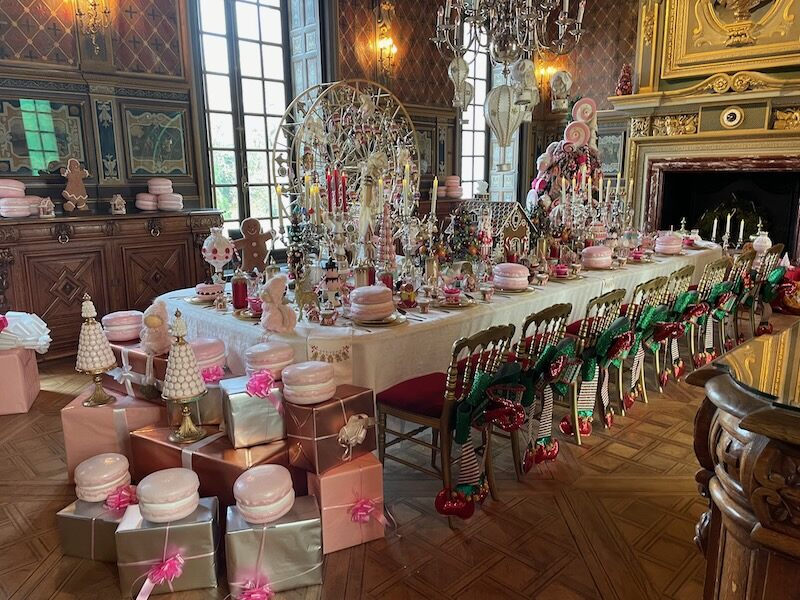 The dining room table heaves under the weight of Christmas in its 2024 version ©OffbeatFrance
The dining room table heaves under the weight of Christmas in its 2024 version ©OffbeatFrance“Christmas here is more heartwarming than, say, Versailles,” said the Marquis de Vibraye.
He’s referring to the personal touch he and his wife Constance put into each season, carefully choosing moods and pieces that will highlight the château’s natural harmony while enchanting entire families. (If you love the holiday season and castles, check out how these 7 Loire Valley castles celebrate Christmas.)
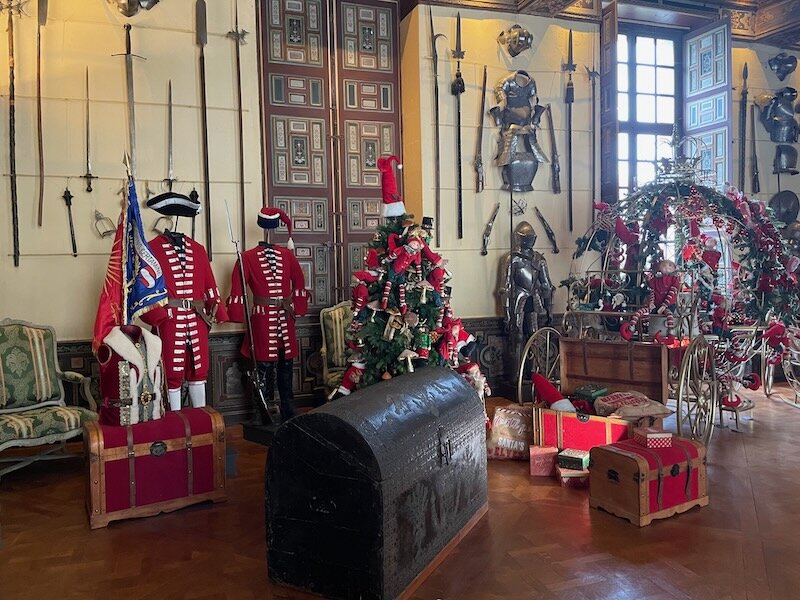 Even the Arms Room doesn’t escape Christmas, but it's all done stylishly ©OffbeatFrance
Even the Arms Room doesn’t escape Christmas, but it's all done stylishly ©OffbeatFranceFASCINATED BY FRENCH CASTLES?
- How Two Remarkable Women Fought Over Chenonceau Castle (and who won)
- 4 Chateaux of Loire valley and their conspiracy theories, lust and secrets
- Chateau Bussy Rabutin And The Salacious Count Who Lived There
- Chinon Castle: Tales Of Heresy, Betrayal, And Liberation
- Voltaire in Love: The Improbable Power Couple of the Chateau de Cirey
6. There are six thematic gardens, including a Garden of Love
Few châteaux can call themselves such if they don’t have glorious gardens, and Cheverny is no exception.
It is home to 1800 hectares (4450 acres) split into six thematic gardens and plenty of grounds, all meticulously maintained by a team of ten gardeners and foresters.
One of the most striking is the Garden of Love, the Jardin de l'Amour, with a set of six bronze sculptures by Franco-Swedish artist Gudmar Olovson. Known as the "Swedish Rodin", Gudmar worked with the owners for seven years to celebrate these different aspects of love.
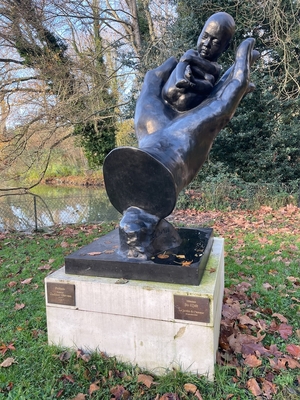
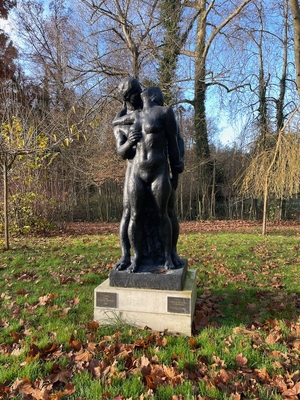
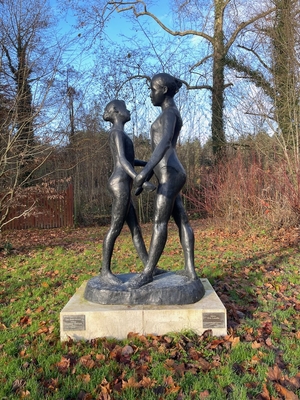
But there's more than just love in the gardens...
- The Vegetable Garden, whose produce is used to prepare the estate's food
- The Maze, an iconic feature in many Renaissance gardens
- The Sweet Garden, the newest on the block, planted during the lockdown, a fruit orchard whose produce is used to concoct the desserts you can taste in the Orangerie Café
- Next to it is the Apprentice's Garden, created by 10 apprentices in 2006
- And finally, come spring, the Tulip Garden carpets the ground with color − but not at Christmas!
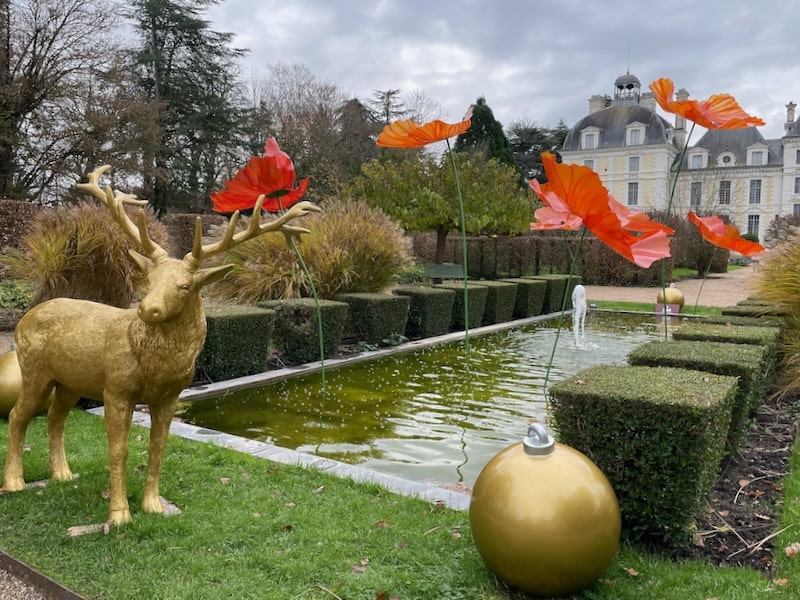 Mixing the modern and the traditional in the Apprentice's Garden ©OffbeatFrance
Mixing the modern and the traditional in the Apprentice's Garden ©OffbeatFranceThe gardens are supplemented by alleys of stately Lebanese cedars, two towering sequoias, and a series of canals along which you can float on boats once the winter is over.
7. Tintin would have felt at home here
I mentioned Tintin earlier on, and if you grew up with this cartoon character (familiar to all French schoolchildren), you’ll instantly feel a stab of recognition the first time you see Cheverny.
Moulinsart Castle, or Marlinspike Hall in the English series, looks just like this, minus the two towers on either side. Author and illustrator, the Belgian Hergé, must have deemed its classical lines easy to reproduce yet distinctive enough when he decided to use it as his model.
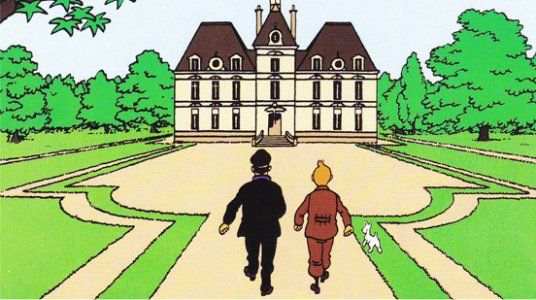
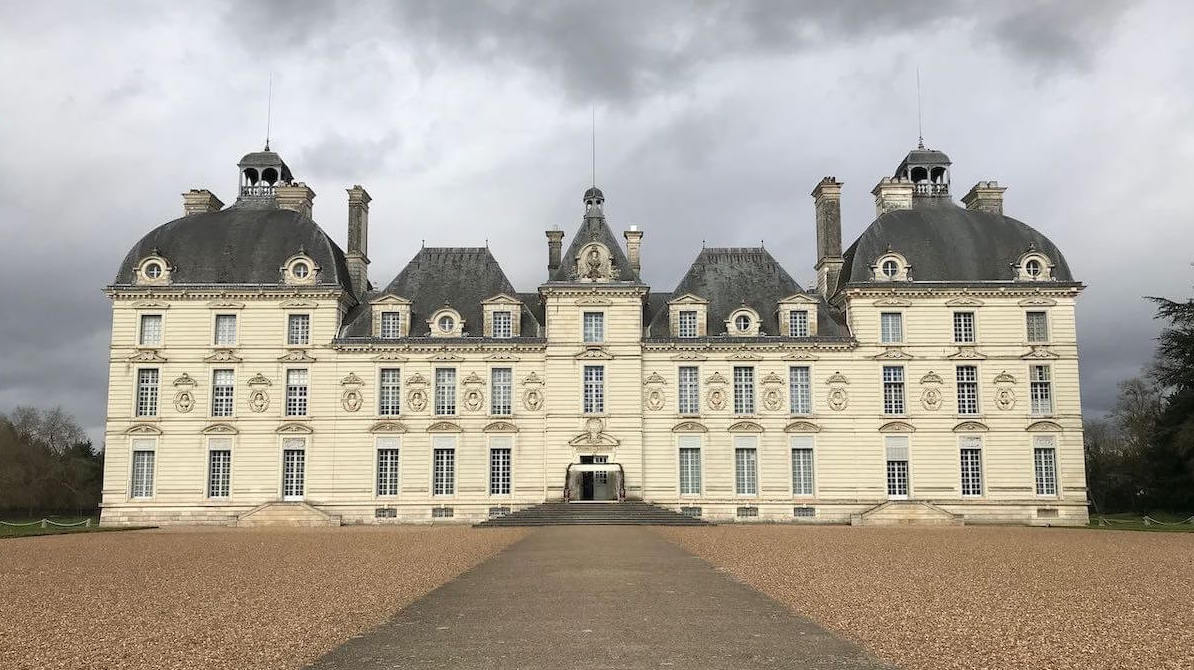 Top: Marlinspike Hall, bottom: Cheverny. Notice the similarities? All that's missing in Tintin's version are the two end towers
Top: Marlinspike Hall, bottom: Cheverny. Notice the similarities? All that's missing in Tintin's version are the two end towersIn case you’re not familiar with The Adventures of Tintin, he’s a cartoon character who scours the world for stories as a reporter, accompanied by his fox terrier Milou (Snowy). His sidekick, the whiskey-drinking foulmouthed seafaring Captain Haddock, is constantly creating havoc, as are the detective twins, Dupond and Dupont (Thomson and Thompson). Plenty of other characters make regular appearances, including Nestor the butler and Professeur Tournesol (Cuthbert Calculus), the absent-minded professor.
Of course if you’re a Tintin fan, you’ll want to stop by the small interactive exhibit on the grounds to see facsimiles of Tintin paraphernalia, but beware, all the references and texts are in French.
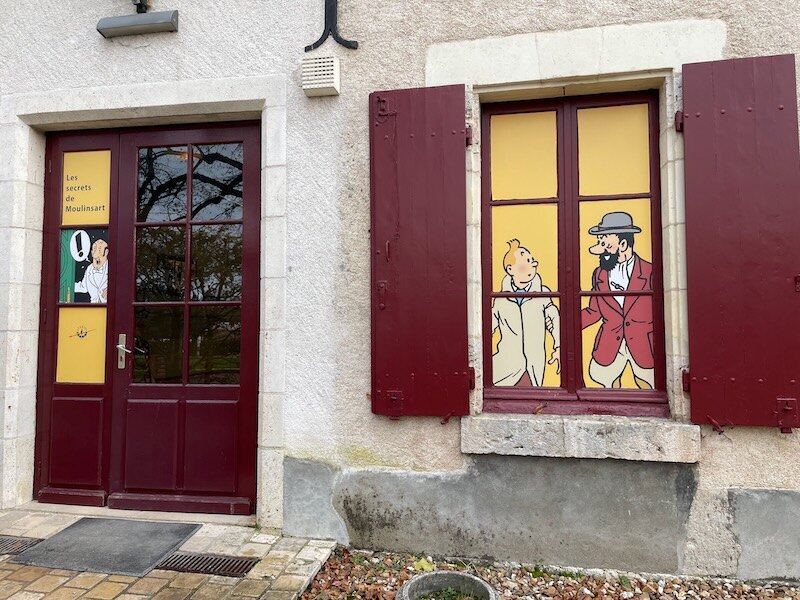 If you’re a Tintin fan, you’ll push open the door and wander around dozens of reminders of your childhood.
If you’re a Tintin fan, you’ll push open the door and wander around dozens of reminders of your childhood.If you’d like to take something home, like a giant reproduction of the rocket from On A Marché Sur La Lune (Destination Moon, also known as Explorers On The Moon), or a little stuffed replica of Snowy, head for the Tintin gift shop, France’s largest dedicated to the comic-book hero.
As a long-time Tintin reader (yes, I've reread them in adulthood), I was definitely drawn to this corner of the estate.
8. The LEGO legacy
As you walk down a 17th-century hallway, your eyes might be drawn to something incongruous, something you think just doesn’t belong: a LEGO version of the Mona Lisa.
No, your eyes aren’t playing tricks on you.
It’s not clear when all this started but I remember my first visit to Cheverny years ago, being surprised by another full portrait of the Mona Lisa made of LEGO bricks.
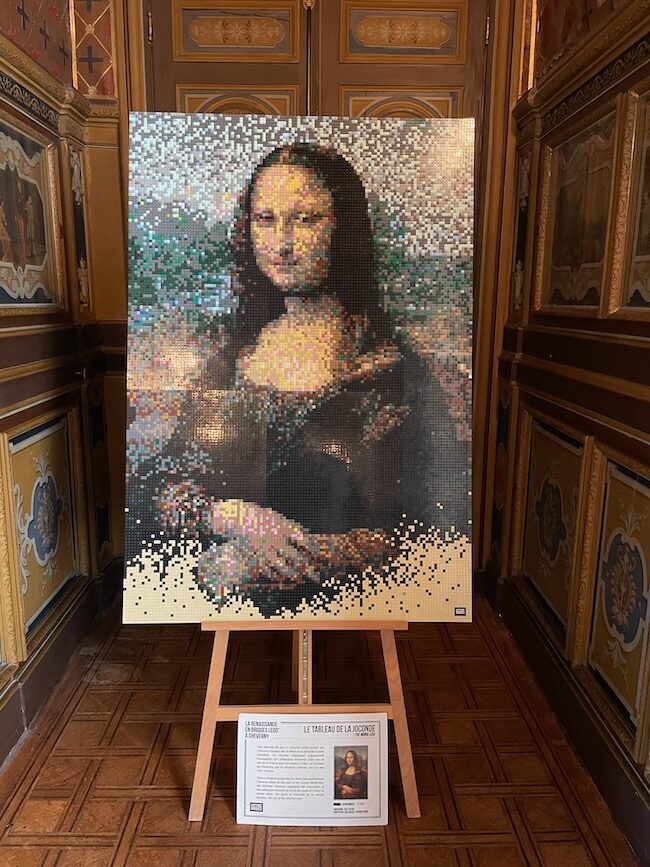 Mona Lisa, courtesy of LEGO ©OffbeatFrance
Mona Lisa, courtesy of LEGO ©OffbeatFrance“It’s for the children,” Renaud Boyer told me.
“It’s an idea the owners had to liven things up. LEGOs are international, and they are also a teaching tool. When a child visits three châteaux a day with their parents, they can be bored. A Louis XV armchair may mean nothing if you’re a kid, but it takes on other properties if it’s reproduced in LEGO. They’re universal.”
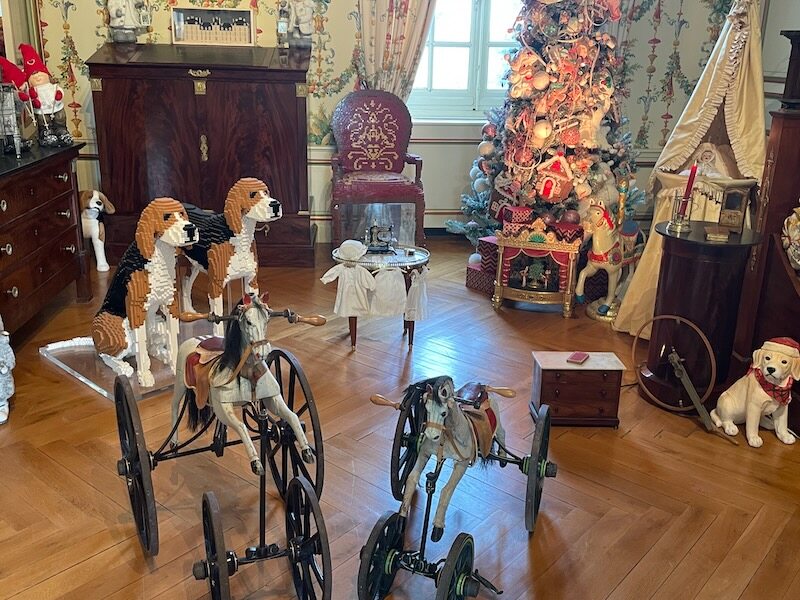 Hounds made of LEGO bricks ©OffbeatFrance
Hounds made of LEGO bricks ©OffbeatFrance9. 120 hunting dogs live at Cheverny
Next to the Tintin exhibit, you’ll hear them before you see them: more than 100 hunting dogs, a cross between English foxhound and French Poitevin. Because yes, this is a working estate, and we are in the Sologne, France’s hunting heartland.
These hounds are bred and trained with care, a tradition that has been part of local life for centuries. While hunting has many pros and cons, locals point out its necessity − unchecked wild boars can wreak havoc on crops and pose real dangers.
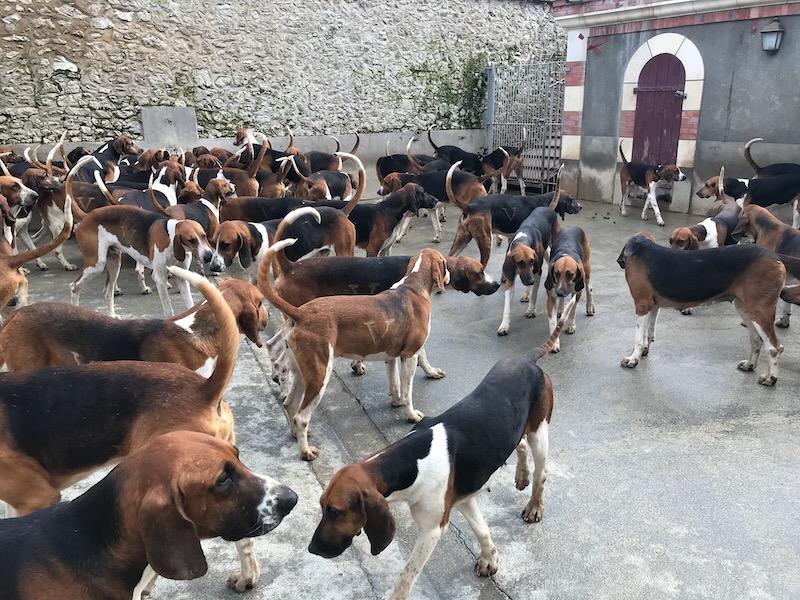 The V on the dogs stands for Vibraye, the owner’s name, but don't worry, the animals aren't branded − the hair is merely trimmed ©OffbeatFrance
The V on the dogs stands for Vibraye, the owner’s name, but don't worry, the animals aren't branded − the hair is merely trimmed ©OffbeatFranceThe public feeding time, once a popular attraction, has been discontinued, but you can still walk up to the fence to observe the hounds anytime.
Watching them interact, whether lounging in the sun or clamoring for attention, is a fascinating look into the daily life of a working hunting estate.
Whatever you think of hunting, the hounds are a living, breathing connection to the estate’s history and the traditions of the Sologne.
Getting to Cheverny
Cheverny is easily reached by car and you can combine a visit here with several other nearby châteaux − like Blois, Chambord or Chenonceau.
For the latest entrance prices, see the château’s website (I couldn’t get the English language icon to work − maybe you’ll be luckier!)
Are you looking for a place to stay? If you are, Cheverny maintains a set of suites right at the château’s entrance and offer a great deal if there are several of you who want to share 2-3 bedrooms.
Before you go...
If you have time, have a meal or a dessert at the Orangery, whose chef, Eric Pillault, concocts deliciousness plucked from one of the gardens. Not your usual bland cafeteria fare. Just another way Cheverny is unique.
You'll love a visit any time of year, but at Christmas, the entire Loire Valley takes on a special mantle. There can't be a much better way to spend Christmas holidays than visiting fairy-tale castles...
Did you enjoy this article? I'd love if you shared it!

